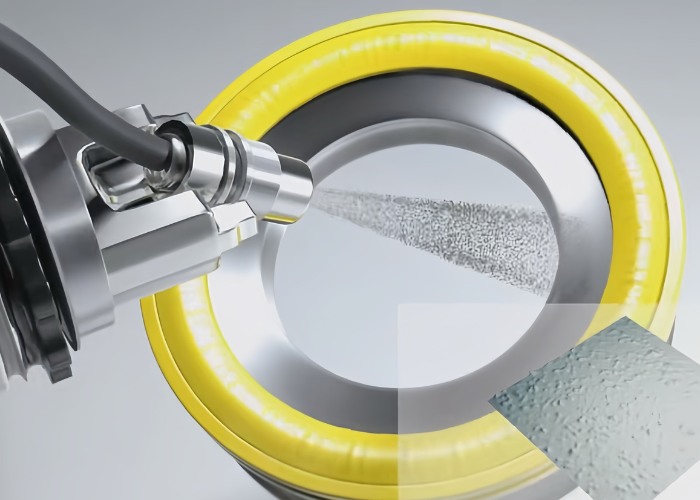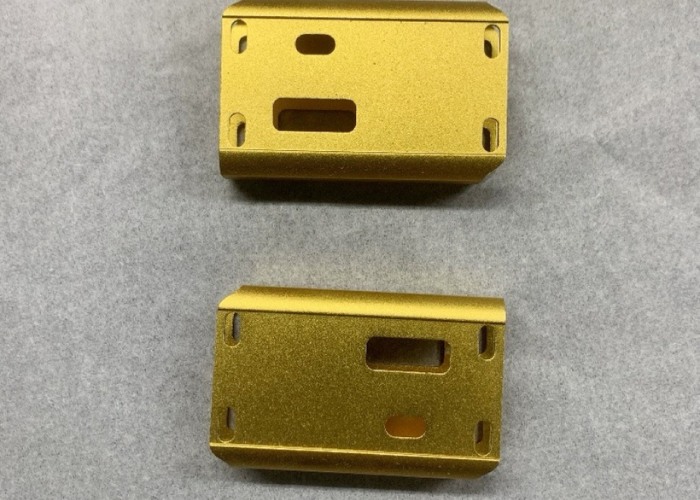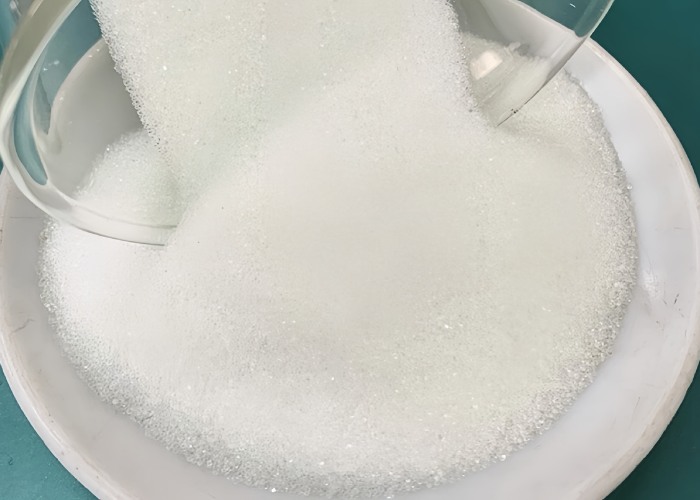
Bead blasting, one of the very common surface treatments in manufacturing, not only improves the appearance and texture of a product, but also its functionality and durability. bead blasting is also widely used in various industrial fields.
This article will delve into the working principles, material selection, advantages and disadvantages, as well as application scenarios of bead blasting to help readers gain a comprehensive understanding of this important surface preparation method.
Through this article, we hope that readers can have a deeper understanding of bead blasting, so that it can be better applied to the actual production and improve the quality and competitiveness of products.
What is Bead Blasting?
Bead blasting is the process of removing dirt, oxidation, coatings or other surface imperfections by shooting tiny spherical particles (called “grit” or “granules”) through a high-pressure air stream onto the surface of a workpiece to improve its appearance, texture and functionality. Increases surface roughness and improves product surface adhesion.
Материал Options for Обработка бисером
There are several types of granular media used in bead blasting, each with unique properties and application scenarios. Below are a few common types of bead blasting granular materials:
1. Glass Particles
Component materials: usually made of silicon oxide, sodium oxide and calcium oxide.
Характеристики: Glass particles are low cost, moderately hard, and will not damage most substrates.
Приложения: Suitable for light surface preparation such as cleaning, removal of oxidized layers and light burring. They are commonly used in processes where surface integrity needs to be maintained, such as the cleaning and maintenance of automotive parts.
2. Ceramic Particles
Component Material: Ceramic particles are usually made of alumina, zirconia, or a mixture of alumina and zirconia.
Характеристики: Ceramic particles are very wear-resistant and hard, suitable for more rigorous treatment of surfaces.
Applications: Suitable for removing thicker oxide layers or initial machined surfaces. They are commonly used in aerospace, electronics and medical devices where surface requirements are high.
3. Aluminum Oxide Particles
Component material: made of aluminum oxide with high hardness and wear resistance.
Характеристики: Aluminum oxide particles have high hardness and good abrasion resistance, and can effectively remove impurities from hard surfaces.
Application: Suitable for treating hard surfaces such as removing oxidized skin, burrs or rough surfaces. They are commonly used for surface pretreatment and processing of metal products.
4. Steel Particles
Component material: usually made of carbon steel or stainless steel, with high hardness and wear resistance.
Characteristics: High hardness of steel particles, high abrasion resistance, suitable for drastic surface treatment.
Приложения: Suitable for removing weld slag, oxidized layers or for rougher surface treatments. They are commonly used in industries requiring deep cleaning and surface preparation such as heavy machinery, shipbuilding and bridges.
5. Plastic Pellets
Component materials: made of materials such as acrylic and polycarbonate.
Характеристики: Plastic granules are softer and are suitable for cleaning surfaces and improving surface quality while maintaining the quality of the substrate.
Applications: For surface treatments that require fine cleaning without damaging the substrate, such as cleaning and maintenance of electronic equipment, molds and precision instruments.
Equipment for Обработка бисером
1. Sandblasters
A bead blasting machine is the core equipment for bead blasting, which treats the surface of a workpiece by spraying a high-pressure stream of air and bead blasting particles. The blast machine can be adjusted according to the different treatment requirements, including adjusting the type, size and pressure of the blast particles, as well as adjusting the direction and speed of the blast.
2. Compressed Air Systems
Bead blasting machines typically require the use of compressed air to generate a high-pressure stream of air to propel the sandblast particles against the surface of the workpiece. Compressed air systems include components such as compressors, cylinders, filters and regulators.
3. Обработка бисером Room
A blasting room is an enclosed space where bead blasting is performed to prevent the spread of sandblast particles and wastes from the process to the surrounding environment. Blast rooms are usually equipped with ventilation systems and dust collection equipment to ensure a clean and safe operating environment.
4. Particle Recycling Systems
Bead blasting produces a large amount of waste, including used sandblast particles and impurities removed from the surface of the workpiece. Particle recovery systems are used to collect and recycle these wastes to minimize resource waste and environmental pollution.
The Operation Process of Bead Blasting
1. Preparatory Work
- Workpiece Preparation: Ensure that the workpiece to be treated is clean, dry and pre-treated as necessary, such as removing grease and dirt from the surface. Solvents or alkaline cleaners can be used to clean the workpiece to ensure that the surface is free of any contaminants that would affect the blast results.
- EQUIPMENT INSPECTION: Check all components of the bead blastingequipment, including the blast machine, compressed air system, blast chamber and particle recovery system, to make sure they are working properly. In particular, check that the nozzles are not clogged, that the compressed air system has sufficient pressure, and that the recovery system is capable of effectively recovering sandblasted particles.
- Safety Protection: Operators need to wear protective equipment, such as protective glasses, protective gloves, protective clothing and respiratory protection, to prevent the dust and particles generated during the bead blastingprocess from causing harm to the human body. Also, make sure the workplace is well ventilated to avoid dust accumulation.
2. Обработка бисером Operations
- Loading sand blasting granules: Select the appropriate sand blasting granules according to the material of the workpiece and the surface treatment requirements, and load them into the sand blasting equipment. Commonly used blast granules include glass granules, ceramic granules, aluminum oxide granules, steel granules and plastic granules.
- Adjustment of equipment parameters: Set the parameters of the sand blasting equipment, including sand blasting pressure, particle flow and nozzle angle. The choice of bead blastingpressure should be determined according to the workpiece material and the desired surface effect, and can generally start from a low pressure and gradually adjust to the appropriate level.
- Operating the sand blasting machine: Start the sand blasting machine, aim the nozzle at the surface of the workpiece and move the nozzle at a uniform speed to ensure that the particles cover the surface of the workpiece evenly. A certain spraying distance and spraying angle should be maintained during operation to avoid damage to the surface of the workpiece. Usually, the spraying distance should be kept at about 10-20 centimeters and the spraying angle should be kept between 30-45 degrees.
3. Control of the Обработка бисером Process
- Uniform blasting: Ensure that the nozzle moves at a constant speed and angle during the sand blasting process, so that the sand blasting particles cover the surface of the workpiece uniformly, avoiding over-blasting or leakage. The operation can be divided into zones for spraying, and complete the sand blasting treatment of the whole workpiece zone by zone.
- Regular inspection: During the sand blasting process, regularly check the treatment effect on the surface of the workpiece, such as surface finish, uniformity and particle removal, and adjust the sand blasting parameters if necessary to achieve the best results. At the same time, pay attention to check the operation status of the equipment to prevent equipment failure affecting the bead blasting
- Control of blasting time: Control the blasting time according to the material of the workpiece and the desired surface effect. Too much time may cause excessive wear on the surface of the workpiece, while too little time may not achieve the desired surface finish.
4. Bead Blasting Post-Treatment
- Cleaning the workpiece: After bead blastingis completed, the workpiece is cleaned to remove residual particles and dust from the surface. Compressed air blowing or washing can be used to clean. Especially for precision parts and workpieces that require subsequent coating, cleaning is particularly important.
- Inspect Surface: Inspect the surface of the workpiece for finish, including surface finish, uniformity, and the presence of damage. Ensure that the surface meets the expected quality standards, and perform additional bead blastingor other surface treatments if required.
- Maintaining the equipment: Maintain and clean the sand blasting equipment, including cleaning the residual particles in the sand blasting chamber, checking and replacing worn-out nozzles and filters, etc., to ensure that the equipment can run stably for a long time. At the same time, check and maintain the compressed air system regularly to prevent insufficient air pressure or air leakage.
5. Disposal of Waste Materials
- Recycling of granules: Used blast granules and impurities removed from the surface of the workpiece are collected and sorted using a granule recycling system. Recyclable abrasive blasting granules can be processed and reused, while non-recyclable waste needs to be treated and disposed of in accordance with environmental requirements.
- Environmental protection: Care should be taken to comply with environmental regulations during the treatment process to avoid environmental pollution caused by the waste and dust generated during the bead blasting Specialized waste handling equipment and methods, such as filters, dust collectors and waste handling systems, can be used to ensure that waste is properly handled and disposed of.
Pros and Cons of Bead Blasting
Плюсы
- Хорошо Surface Cleaning Effect
Bead blasting can effectively remove dirt, oxidized layer and other impurities on the surface of the workpiece, making the surface clean and flat.
- Controlled Surface Roughness
By adjusting the particle size of the blasting media and the blasting pressure, the roughness of the surface of the workpiece can be controlled to meet the needs of different applications.
- Improvement of Coating Adhesion
Bead blasting can form microscopic bumps on the surface of the workpiece, increase the adhesion between the coating and the surface of the workpiece, and improve the durability of the coating.
- More Environmentally Friendly
Compared to some chemical treatment methods, bead blasting is a chemical-free surface treatment method that is friendly to the environment.
- Wide Range of Applications
Bead blasting can be used on different types and shapes of workpieces, including metals, plastics, glass and other materials.
Cons
- May Cause Surface Damage
During the blasting process, the particles sprayed at high speed may cause some damage to the surface of the workpiece, especially for soft or thin-walled workpieces.
- Generation of Dust and Waste
The bead blasting process generates a large amount of dust and waste that requires appropriate measures for disposal and cleanup, increasing the cost of the job.
Hazardous to operators: Dust and waste materials generated during the bead blasting process may be hazardous to the health of operators and require protective measures.
- High Equipment Requirements
Bead blasting equipment requires a certain level of pressure and blast media control, which is more demanding and costly to maintain.

Как Get the Best Обработка бисером Results?
- Keep the surface of the parts clean and dry
Before bead blasting, make sure the surface of the workpiece is free of oil or moisture. Oil and moisture can hinder the blasting results and affect the final appearance.
- Selection of suitable sand blasting materials
Select the appropriate sand blasting media according to the material of the workpiece. For example, glass sand is suitable for aluminum products, and sand with a fineness of 120# is recommended to achieve the best results.
- Adjust the blasting angle and distance
Keep the gun approximately 20 cm away from the workpiece and tilt it at a 45 degree angle to ensure maximum blasting coverage.
- Choose the right nozzle
The shape and size of the nozzle has a direct impact on the quality of bead blasting. Usually, 8-15mm nozzle aperture is the most suitable. If the nozzle aperture is enlarged by more than 25%, the nozzle should be replaced to maintain the effect.
Application of Обработка бисером
- Automobile Industry
It is used for the surface treatment of automobile parts, such as engine block, chassis parts, etc. It can remove the oxidized layer, paint and rust, and provide a good foundation for the subsequent painting or plating.
- Aerospace
It is used for the surface treatment of aircraft parts, such as engine parts, fuselage structure, etc. It can remove the oxidized layer and coating, repair the surface defects, and improve the surface quality and service life of the parts.
- Medical Equipment
It is used for the treatment of the surface of medical devices, such as surgical instruments, implants. It can remove the surface dirt and oxidized layer, and improve the hygienic and corrosion-resistant performance of the instruments.
- Shipbuilding
It is used for the treatment of ship surfaces, such as hulls and decks, etc. It can remove marine organisms, rust and coatings from the hull surfaces, protect the hull surfaces and prolong the service life.
Заключение
By gaining an in-depth understanding of bead blasting material selection, processes and delicate handling methods, you can ensure that the bead blasting process achieves optimum results. bead blasting is more than just a surface preparation technique.It plays a vital role in machining and manufacturing. Choosing the right blasting technology relies on the specialized experience of mechanical engineers and strict quality control.
At Tirapid, we are committed to delivering machining services that meet high standards for your sandblasted products.
Вопросы и ответы
How to design sandblasted parts?
When designing the parts, it is necessary to consider the requirements of surface treatment and select the appropriate blasting media and treatment parameters to ensure that the final treatment effect meets the requirements.
What safety issues do I need to be aware of with bead blasting?
bead blasting produces dust and waste materials, and appropriate measures need to be taken to protect the operator and the environment, such as wearing protective glasses and masks, providing good ventilation systems, etc.
Is further surface preparation required after bead blasting?
Blasting usually produces a degree of surface roughness that may require further surface preparation, such as polishing or coating, to meet specific requirements.

